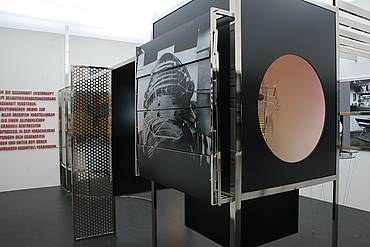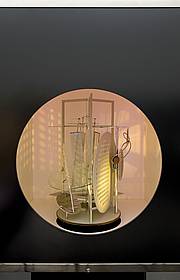 In addition to being the subject of his film and photographic work, Laszlo Moholy-Nagy’s Light Space Modulator modulated light and space as a sculptural installation, and it served as a Light Prop for an Electric Stage. But in 1930, the artist had also planned on installing it at the Hannover Provincial Museum.
In addition to being the subject of his film and photographic work, Laszlo Moholy-Nagy’s Light Space Modulator modulated light and space as a sculptural installation, and it served as a Light Prop for an Electric Stage. But in 1930, the artist had also planned on installing it at the Hannover Provincial Museum.
Alexander Dorner, the director of the Landesmuseum, had invited Moholy-Nagy to design the final room in the chronological reinstallation of the museum’s collection, the Raum der Gegenwart, The Room of the Present Day. The room was to have interactive exhibition elements devoted to film, architecture, and design. And at its center: the definitive art work of Moholy-Nagy’s future, the Light Space Modulator, performing inside its light-lined cabinet. Was to have, because Moholy Nagy’s plans were never realized in Hannover.
Frankly, it sounds more like the Room of the Multimedia Future. In the press release for Licht Kunst Spiele, an exhibition of Light and the Bauhaus last year at the Kunsthalle Erfurt, the Room of the Present Day was said to have anticipated “an art which does completely without the hand-painted, auratic picture.” [Anticipated is right; Walter Benjamin didn’t write “The Work of Art in the Age of Mechanical Reproduction” until 1935. I guess aura was in the air.]

And speaking of reproduction, the curators for that show, Drs. Kai Uwe Hemken and Ulrike Gärtner teamed up with designer Jakob Gebert to finally realize Raum der Gegenwart according to Moholy-Nagy’s designs and intentions. From the photos, the Raum looks like a life-size Light Space Modulator, the Light Prop transfigured into a Light Stage. Or Light Theatre.

The Raum traveled to Frankfurt for the Schirn Kunsthalle’s Moholy-Nagy retrospective, and it has now settled into the Van Abbemuseum in Eindhoven, where it is part of Museum Modules, a show about, I guess, famous museum exhibition re-enactments. [images via crossroads mag and vanabbemuseum.nl]

Whether that is the Van Abbemuseum’s 1970 Light Space Modulator in there, or yet another replica, I don’t know, but I’ll assume it’s the former. Perhaps the answer lies in “The Raum der Gegenwart (Re)constructed,” a thorough and fascinating-sounding article by Columbia’s Noam M. Elcott, which was recently published in the Journal of the Society of Architectural Historians.
update: Yes and no. Elcott’s article is fascinating, though, and he praises the “historical acumen and curatorial courage” of putting the Light Prop in the lighted box it was arguably conceived for. He goes further, arguing persuasively that Light Prop, as an embodiment and producer of cinematic abstraction, is the conceptual center of the Raum der Gegenwart. Very interesting stuff.
Skip to content
the making of, by greg allen
